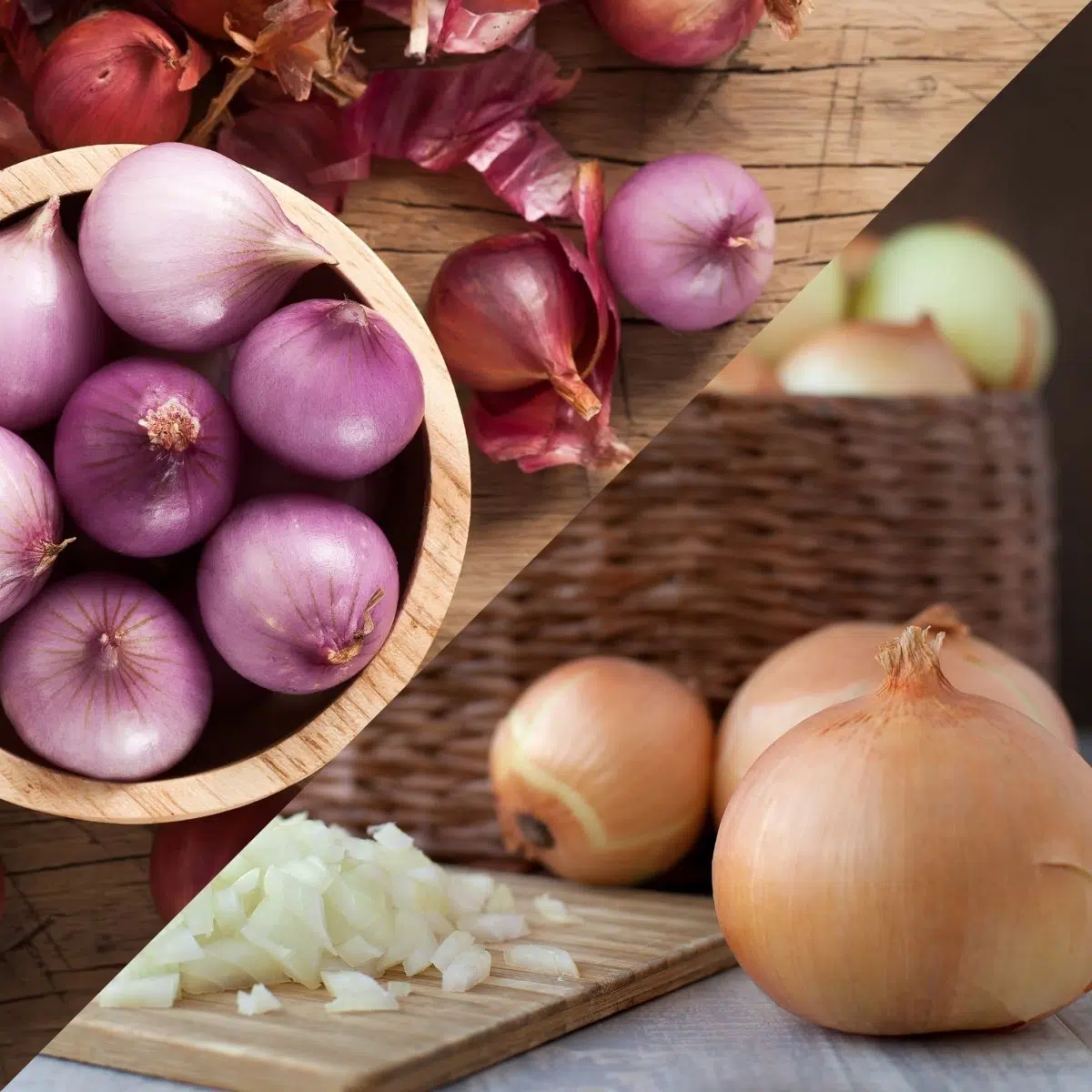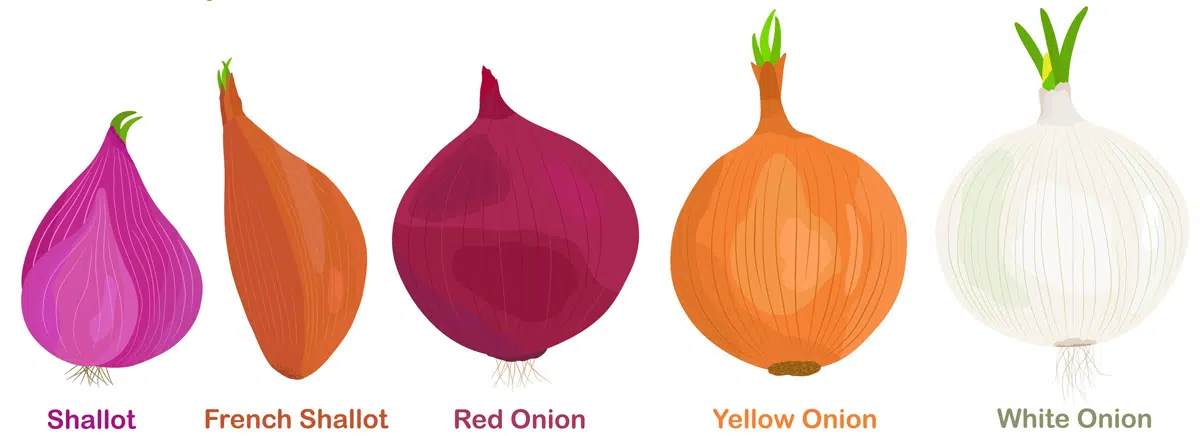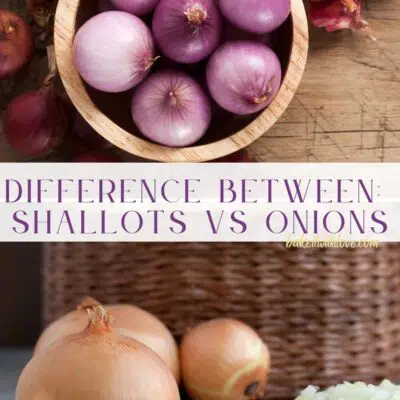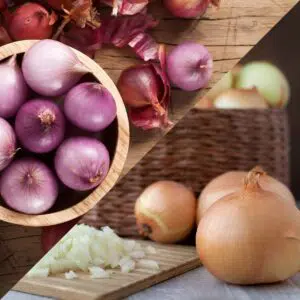When you're wondering about shallots vs onions: what are the differences, the similarities, and how do you know which one is best to use - look no further! For answers to these questions and all things shallot and onion related, check out this comprehensive post.

Jump to:
Even though I am starting this with shallots vs. onions, I have to say that it's not fair to put shallots and onions in competition with one another. They are both amazing!
Since they do have many similarities though, they often get compared to one another. However, even though they each have their own distinct and delicious taste (and aroma), one is not better than the other.
Each one has its own place in the kitchen. Plus, they can also often be used in place of one another.
What is a Shallot?
You have probably seen shallots in the grocery store. Often located next to the garlic and onions, you may have even wondered if it was a large piece of garlic or a small onion.
This description is close, as shallots have similarities to both. The main reason for their similarities is that they are all varietals of the allium family. Allium vegetables also include other flavor-rich foods like leeks and chives.
What do Shallots Taste Like?
While shallots have a strong flavor that reflects a similar sharpness to an onion, it is much milder. It is also much sweeter and even includes a note of garlic.
This complex flavor profile is a wonderful balance of flavors.
What are Shallots Used For?
The combination of its mild pungent taste and distinct sweetness makes shallots a wonderful choice for many dishes. The taste holds up well when cooked, while also being delicious in cold dishes.
Many find that their balanced taste is a good choice for dishes where onions may overpower other flavors. Those who enjoy a rich flavor, but not the pungency of onions, may also enjoy shallots as a new alternative.

What is an Onion?
As one of the most popular foods worldwide, defining what an onion is may seem kind of silly.
To make a clear comparison though, it can be helpful to understand more about this common food. That way you can better understand how their similarities and differences. Therefore, you can better understand how one may or may not be used in place of the other, as well as which one you may prefer.
As members of the allium family onions are known for having a strong and pungent taste. The pungency depends on which type of onion you are cooking with, as yellow, white, red, and green onions all have slightly different levels.
Health Benefits of Onions
Before discussing the varying tastes of onions, it is worth noting the health benefits of these bulbs.
Onions are one of the best foods you can eat when it comes to your health. Full of flavonoids, onions are often referenced for their cancer-fighting properties.
Before you run out and start adding onions to everything though, be aware that too much of a good thing can be a bad thing. As with most foods, onions are best eaten in moderation.
What do Onions Taste Like?
The taste of an onion depends on the type of onion. While all onions have a similar "oniony" taste, the potency of that taste varies from onion to onion.
Yellow onions
Yellow onions have a clear onion taste with a bit of sweetness. They are the most common type of onion and can be recognized by their brown peel.
Yellow onions maintain their strong pungent flavor when heated, which makes them a popular choice when cooking. They can also be used in their raw form, although many feel the taste of raw yellow onions can be a bit overpowering.
White onions
White onions have a straightforward onion flavor profile. While it is sharp, it tends to be milder than a yellow onion.
However, this mildness does not hold up under heat the same way that a yellow onion does. Therefore, white onions are best used to add a distinct onion flavor to cold dishes like salads and even salsa.
Red onions
Is it a red onion or a purple onion? That is up for debate. Despite clearly being purple on the inside, it is technically called a red onion- so we will follow suit.
Red onions have a strong flavor profile that is a nice balance between the pungency of a yellow onion, with a hint of sweetness. This balanced flavor gives them the perfect taste (and look) to eat raw.
Green onions
While green onions are less pungent than the other three larger varieties, they still have the distinct flavor of an onion.
The milder flavor is a result of green onions technically being young onions. Since they have not fully grown into a mature onion, their flavor is milder and less pungent. This flavor is well suited as a raw addition to salads or other cold dishes.
Chives
While chives are an herb and not an onion, they are often described as having an "oniony taste". Chives are frequently confused with, or used interchangeably with, green onions but they are not the same!
For more about the differences between green onions and chives check out my comprehensive post.
>>>See All Of My Tasty Recipes Here!<<<
What are Onions Used For?
Onions are mostly used to add flavor to a dish. They are easy to find worldwide and popularly used in cuisines around the world.
As mentioned above, different onions work better for different dishes though. Therefore, it is best to consider which type of onion is best suited for your recipe.
Yellow onions are your best choice for adding flavor to cooked dishes since they will maintain their flavor. While white onions can also be cooked, they are better suited for a nice bright onion taste in a cold dish.
Both red and green onions are best used raw. Both are tasty options to chop up and add to a salad. Green onions are also great as a final addition to add on top of a steak or baked potato, just before serving. You can even use these onions in marinades and dressings.
Can you Substitute Onions for Shallots?
If you have never tried a shallot, I highly recommend giving them a go at some point. Even if you end up loving shallots though, there is always the possibility you may need a substitute eventually.
Since you will probably have an onion on hand, you may wonder if you can use it in place of shallots. Yes, you most definitely can!
Onions can be a great substitute for shallots. As with any substitute though, you will want to determine which onion is best suited for a substitution.
If you are ready to learn about the best substitutes for shallots, head on over to this article. I break down all the ways to use onions as a substitute for shallots and also provide several other substitutes (besides onions).
Can you Substitute Shallots for Onions?
If onions can be used as substitutes for shallots, then it makes sense that shallots can also be used as a substitute for onions.
When subbing shallots for onions, the main thing to consider is what type of flavor the onion is meant to add to the dish. The main flavor to consider is the sweetness found in a shallot.
This sweetness tends to come through a bit more when the shallots are cooked. So, while this will be a welcomed flavor exchange in most dishes, it may not work quite as well in others.
Raw shallots on the other hand are an easier substitute for raw onions. The sweetness in raw shallots is not as pronounced, and overall, they are less pungent than raw onions.
Shallots also have a more similar flavor profile to red and green onions, which are the two more common types of onions used raw.
Are Shallots Better Than Onions?
There is no clear winner when you compare shallots to onions. Each one offers its own distinct flavor and purpose in a recipe.
You may find that you prefer one over the other though. Therefore, take some time to explore shallots and see how they compare to onions when it comes to your taste buds!
Do you love a recipe you tried? Please leave a 5-star 🌟rating in the recipe card below and/or a review in the comments section further down the page.
Stay in touch with me through social media @ Pinterest, Facebook, Instagram, or Twitter! Subscribe to the newsletter today (no spam, I promise)! Don't forget to tag me when you try one of my recipes!
📖 Recipe Card
Shallots vs Onions: Differences, Similarities & How To Use Each Best!
Ingredients
- ¼ cup shallots (diced, shallot or French shallot)
- ¼ cup red onion (diced)
- ¼ cup yellow onion (diced)
- ¼ cup white onion (diced)
(Note: 2x or 3x only changes the ingredient list)
Instructions
- Use diced shallots in dishes that you don't want the main ingredients over-powered. My favorite recipes for risotto always use shallots!
- Use diced red onion for a strong onion flavor that is suitable for using raw. Think onion slices for burgers, diced onion garnish, and pico de gallo.
- Use diced yellow onion for a good onion flavor that also features a hint of sweetness. Some varieties are sold as 'sweet' yellow onions, like Walla Walla onions.
- Use diced white onion for a slightly milder onion flavor that is best used in cold dishes, as garnish, and for mild onion flavor in cooked recipes.



Comments
No Comments